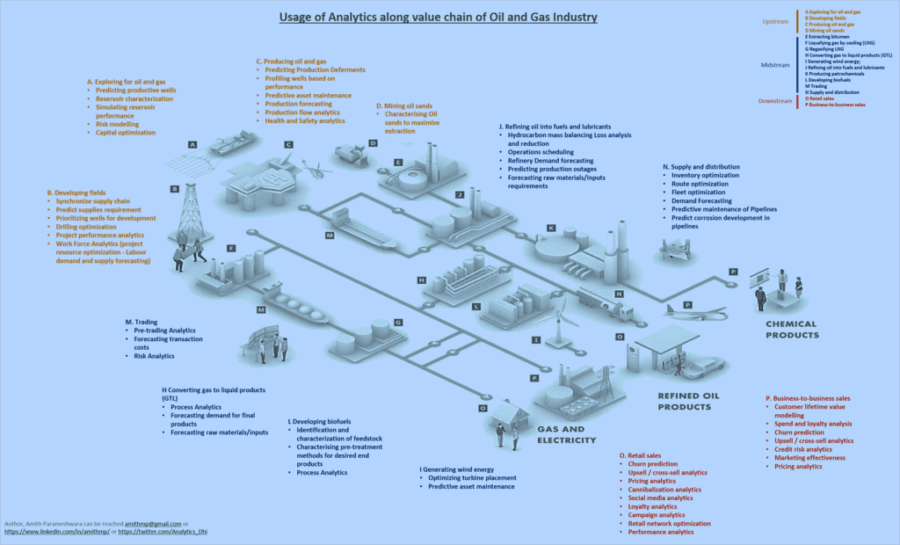Over the decades, oil and gas companies have built their core skills in many areas such as engineering innovation, project execution, process management, risk management etc. These core capabilities have been traditionally serving as the key value levers for companies in this sector. As benefits from these levers reach plateau, along with pressure from oil price, policy risks, political risks etc, these companies are looking at fortifying these levers with big data analytics as well as using big data analytics as a new lever for growth.
It is not that oil and gas industry is totally new to using big data and analytics to make decisions. Upstream, particularly the Exploration phase, has been using statistics in various ways much before analytics become a full-fledged industry. However, advancement in big data technology, developments in machine learning algorithms and tools, availability of advanced analytics talent are all together helping organizations in this domain towards pervasive and fresh use of analytics across the value chain. Yet oil and gas industry is comparatively slow in adopting analytics compared to other domains such as financial services, telecom, retail etc. One reason is lack of exposure and awareness among top executives about new age analytics domain– particularly in terms of latest developments, talent management and frameworks required for effective development and deployment of analytics solutions. This typically handicaps those executives in bootstrapping the analytics division. This also makes it difficult for analytics leaders in these organization to blend the culture of analytic division comprised of analytics talent form other industries with rest of the organization. Oil and gas companies are typically very complex in their structure, processes and culture. This along with constraints such as slow decision making, difficulty in obtaining right data (due to legacy data systems, restrictive data policies, data quality issues etc), lack of integrated data and analytics strategy, and lack of top management mandate all make it difficult to reap full benefits from analytics in the organization.
 Finally, another major bottleneck in effective utilization of analytics is inability to recognize value that analytics bring to the business. Leaders of analytics divisions in oil and gas companies typically are recruited internally. While these leaders with their internal network, intricate understanding of organizational culture can be very helpful in easier integration of analytics division with rest of the organization, their lack of exposure to latest developments in new age analytics makes it difficult for them to create right use cases for analytics across the value chain. This infographic (click here for bigger diagram) depicts how analytics can be applied to various areas of the oil and gas value chain. Analytics leaders need to consider all these possibilities, develop right business cases and deploy right resources to develop and deploy these analytics solutions. A report from Bain estimates that analytics can help oil and gas companies improve production by up to 8% which translates to billions of dollars. Effective adoption of analytics across full value chain therefore can be much more beneficial and transformative for these organizations. However, to make this happen analytics leaders in these organizations need to first imagine the possibilities!
Finally, another major bottleneck in effective utilization of analytics is inability to recognize value that analytics bring to the business. Leaders of analytics divisions in oil and gas companies typically are recruited internally. While these leaders with their internal network, intricate understanding of organizational culture can be very helpful in easier integration of analytics division with rest of the organization, their lack of exposure to latest developments in new age analytics makes it difficult for them to create right use cases for analytics across the value chain. This infographic (click here for bigger diagram) depicts how analytics can be applied to various areas of the oil and gas value chain. Analytics leaders need to consider all these possibilities, develop right business cases and deploy right resources to develop and deploy these analytics solutions. A report from Bain estimates that analytics can help oil and gas companies improve production by up to 8% which translates to billions of dollars. Effective adoption of analytics across full value chain therefore can be much more beneficial and transformative for these organizations. However, to make this happen analytics leaders in these organizations need to first imagine the possibilities!
Author: Amith Parameshwara is a Principal in the analytics division of Dell EMC. Views expressed are his own and not represent the companies he is working currently or worked earlier. He has nearly 17 years of experience in the technology industry across diverse functions and domains including analytics. He can be contacted at [email protected] or @Analytics_Dhi

Great article on how analytics can enhance value in the oil and gas sector! Excited to see how companies like ExxonMobil leverage these insights for better decision-making.